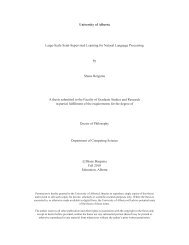The high altitude wildlife areas of western Arunachal Pradesh
The high altitude wildlife areas of western Arunachal Pradesh
The high altitude wildlife areas of western Arunachal Pradesh
Create successful ePaper yourself
Turn your PDF publications into a flip-book with our unique Google optimized e-Paper software.
Appendix 5<br />
node 6 . Besides their ability to uncover structure in the data, tree analysis allowed us to<br />
choose appropriate variables and devise prediction rules that can be rapidly and<br />
repeatedly evaluated. Decision trees thus <strong>of</strong>fer a significant advantage over other<br />
classification methods, particularly in situations where prior data from the field are<br />
strong.<br />
First, decision trees were obtained using only spectral data and their derived<br />
indices (reflectance in bands 1-7 and NDVI) for ground points had been assigned to<br />
the above a priori vegetation classes. This analysis helped identify the essential set <strong>of</strong><br />
spectral variables based on which vegetation classes could be obtained. Subsequently,<br />
for the same set <strong>of</strong> points, we also obtained a decision tree based on elevation.<br />
Vegetation Classification<br />
We used a hybrid rule-based classification procedure, whereby an integrated set <strong>of</strong><br />
rules was obtained from the two decision trees (spectral and altitudinal). <strong>The</strong>se rules<br />
were then transferred to the Knowledge Engineer module <strong>of</strong> ERDAS Imagine and<br />
cross-checked for conflicts before being implemented under its Knowledge<br />
Classification system. A majority filter was applied on the resulting image to remove<br />
specks. <strong>The</strong> pixels remaining unclassified (due to cloud-cover and shadow) were<br />
retained and are reported as such.<br />
Delineation <strong>of</strong> proposed <strong>wildlife</strong> reserve<br />
We used topographic features to delineate the boundaries <strong>of</strong> the proposed <strong>wildlife</strong><br />
reserve in the region identified in Chapter 2. This was done by first marking out<br />
individual basins in the Mago Chu Valley and <strong>high</strong>er West Kameng survey regions.<br />
We then added a set <strong>of</strong> adjacent basins, taking care to minimize protruberances and<br />
invaginations into the boundary. We chose to leave out as much <strong>of</strong> the permafrost<br />
<strong>areas</strong> as possible owing to their low biological significance, and because <strong>of</strong> the intrinsic<br />
protection due to their remoteness and hostile conditions.<br />
Decision tree outputs<br />
<strong>The</strong> decision tree based on elevation produced a first-level split at 4049 m, which<br />
effectively was the tree-line, with closed-canopy forested habitats falling below, and<br />
open scrub-grassland habitats falling above it (Fig 1). <strong>The</strong> reported misclassification<br />
rate was 25%. Conifer-Broadleaved forests (CBL) were the most variable class even in<br />

















